A Guantanamo Tour: ‘Much Ado About Nothing’?
In vivid detail, Jason Leopold describes daily life for both the detainees and guards at the facility.
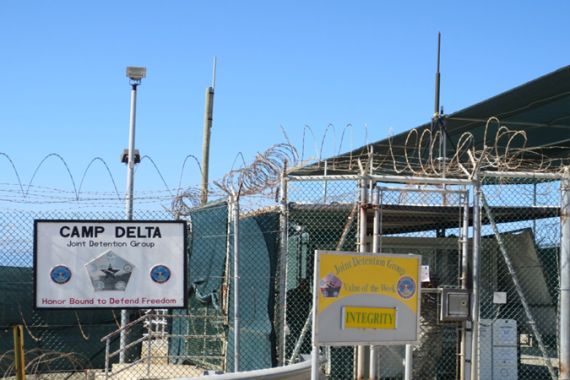
Guantanamo Bay, Cuba – A bearded man in white appeared in the narrow window that faced the gravel walkway leading to the world’s most famous detention camp.
He stood without a word, surveying the scene outside, where Army guards were unloading containers from a van and stacking them onto a dolly. Inside were Styrofoam clamshells that held the morning’s breakfast meals – cereal, fruit and nutrition bars that soon would be rejected and tossed into the garbage.
Keep reading
list of 4 itemsMasked Tunisian police arrest prominent lawyer for media comments
Gaza’s mass graves: Is the truth being uncovered?
Tunisia: The migration trap
A few hundred feet away, beyond the razor-wired fence, buses dropped off dozens of nameless Army guards reporting for a new day of duty at Gitmo.
Electric wands wielded by other soldiers scanned the guards’ bodies for contraband, which could be anything from a weapon to an unauthorized food product to an iPod. The smokers among them dropped their butane lighters into a cement planter before crossing into the forbidden zone.
The bearded man looked toward the American flag hanging like a portrait on the guard tower, and then he looked at me, standing there with pad and pen at the ready, hoping to discern some essential truth about this mysterious place.
Raising his left arm, the man in the window gave me a “thumbs down” sign, repeating the gesture over and over again. Then he disappeared into his cell.
The military escorts could not – or would not – identify the bearded man. To them, he was just one of 166 “unprivileged belligerents,” a euphemism President Barack Obama adopted during his first term to replace “enemy combatant” used by George W. Bush to describe the men held at the Guantanamo Bay detention facility.
But it was difficult to see anything other than a human being in the window that morning in mid-May – a man expressing his thoughts, presumably, about being locked in a cage for what likely was more than a decade in captivity.
Morning prayers had just ended in Camp 5, a ritual that few outsiders have witnessed. Earlier, at 4 a.m., I was one of four journalists escorted to the camp for a rare opportunity to listen to hunger-striking prisoners pray. Our little entourage included a reporter and photographer from CNN and a photographer from Time magazine.
We entered the detention camp and were led to Bravo block, where the prisoners were still sleeping, unaware of our presence. Even after they woke, they couldn’t see us, and we couldn’t see them. We remained silent, lest they feel like circus animals on display. Even so, it was hard not to feel like a reluctant voyeur.
| Morning prayers at Guantanamo’s Camp 5 |
Two guards strode up and down the block, peeking into the windows of the cell doors to make sure the prisoners were breathing. Another guard stood at the entrance to Bravo block. All wore face masks with a blue stripe labeled “splash shield,” to protect against the reportedly not uncommon practice of prisoners “splashing” guards with bodily waste.
Camp 5 is the same camp where a young Yemeni named Adnan Latif had died eight months earlier from what an autopsy concluded was an overdose of anti-psychotic medication. Guards apparently were not as attentive then as they were on this day, according to a military investigation into the death of Latif, who was among the first prisoners to arrive at Guantanamo – but not the first to leave in a box.
I was reminded of this as we three journalists lurked in the shadows, not far from where Latif reportedly took his own life, rather than spend another decade waiting for the wheels of Gitmo justice to rectify what a federal judge and two administrations had determined was a mistake.
Suddenly a bean hole on one of the cell doors opens and the dark arms of a prisoner reach out to grab an object from a guard. I can’t see what it is. The bean hole closes.
Someone begins the call to prayer from inside another cell. His voice rises, the acoustics of the cellblock lending an operatic quality. In the distance, we hear the voices of other prisoners in other areas also praying. The guards continue to walk the block, peeking into the windows of the cells. After about 20 minutes, the prayers end and we’re ushered out.
Soon, the guards will attempt to serve prisoners breakfast.
Starving for answers
Amid the chaos of the four-month-old hunger strike, which began Feb. 6, the morning prayers represented a rare moment of beauty, of peace, at a prison once dubbed the “least worst place”. Representing Al Jazeera, I spent five days at Guantanamo hoping to gain a better understanding of the dynamics of the place, the reality of those who live and work there, and the underlying circumstances of those who are detained there and have been waging a hunger strike that continues to grow in numbers.
What I discovered was that it is impossible to arrive at any reliable truth of the matter, especially when access to the prisoners is prohibited.
Guantanamo tours are carefully scripted and well-choreographed to provide the military an opportunity to impress upon the media their own reality of life inside the wire; and it does not include any of the recent stories of abuse the prisoners have related to their attorneys since the start of their protest.
It’s the Guantanamo prisoners, military officials insist, who are abusive. They are also ungrateful liars – manipulative, deceptive and “not really hunger-striking.” Despite that, they are still treated with respect by the guards who watch over them.
“The guard force puts up with a lot of abuse from detainees,” Lt. Col. Samuel House, a spokesman for the prison, says over breakfast at the mess hall. “They are splashed with feces and urine every day. They are true heroes for what they have to contend with.”
To back up these assertions, public affairs officers escorted us to an empty cellblock at maximum security Camp 5, where “noncompliant” and “uncooperative” prisoners are held in isolation.
The ceiling of the cellblock is covered with thick foam padding. We were led to one square piece of foam that was stained with what the officer in charge of the camp said was dried feces.
“It’s been like that for about a year,” said the officer in charge, who would not disclose his name. “We tried to clean it, but the shit just won’t come off.”
There is further support for these assertions from the prisoners themselves, though the context may differ.
Unclassified notes I obtained from defense attorneys representing prisoners, contain statements from prisoners who reported that they have splashed guards in retaliation for physical and psychological abuse they say they were subjected to.
Even in the absence of outright abuse, the Guantanamo experience is dehumanizing in almost every respect, including a ban on communication between captives and captors. A sign outside the detention camps reads: “Detainees in Vicinity – Maintain Silence”.
 |
| A warning sign, but why the need for silence was never explained [Jason Leopold/Al Jazeera] |
This is perhaps reflected in the prisoners’ artwork, which was displayed on a bulletin board “for you guys,” according to a prison library technician named Milton, who, like everyone else we encountered at Gitmo, has no last name.
“I was told to hang this bulletin board up so you can see what the detainees do,” he said.
What was fascinating is that a human being could not be found in a single piece of artwork, nor did any contain the names of prisoners who created it. There were drawings of Mecca, camels and one that at first blush looked like an interrogation room.
The military will not discuss individual prisoners by name, or even by their internment numbers. Camp guards wear numbers on their uniforms in place of their own names. Anonymity serves not only as a security measure, but as a deterrent to guards forming a bond with the prisoners.
Meanwhile, hospital staffers charged with their medical care wear fictitious nametags adopted from Shakespearean plays – presumably to maintain security while still maintaining a connection of sorts to their patients. I had to wonder if the captives grasped the irony of being nursed by “Leonato” from Much Ado About Nothing .
A Day in the Life
The captives are referred to as detainees and any other description will result in a swift correction from the military.
“They are not prisoners,” a guard said. “They are detainees. This is a detention facility, not a prison.”
It is difficult to discern the distinction.
The U.S. Navy base at Guantanamo is divided into four “camps,” each housing different types of prisoners. On one end of the spectrum is Camp Iguana, which once held juveniles as young as 12. It now contains the most privileged of the captives, those who have agreed to cooperate with the military in the prosecution of others, or who have been cleared for release – a particularly difficult state of limbo for some who have languished here for several years awaiting “resettlement.”
Camp Iguana was off limits to us during last month’s tour, but we were told it is a dormitory-like setting – and that one detainee even has a pet cat.
Then there is Camp 7, a highly classified area of which no one will even speak – not for the record anyway. It is here where more than a dozen “high value” prisoners, like confessed al Qaeda kingpin Khalid Sheik Mohammed, who was waterboarded 183 times in the span of a month, are being held. KSM, as he is known, is a former CIA captive accused of masterminding the terrorist attacks of Sept. 11, 2001.
The secret lockup – run by a clandestine military team called Task Force Platinum, and monitored by the International Committee of the Red Cross – was also off limits to the media. No one will even discuss its exact location, but it can easily be found on Google maps.
The majority of prisoners – 130 of the 166 at Guantanamo – are held in either Camp 5 or Camp 6, where guests occupy 95-square-foot cells. The walls and floor are bare concrete, with a single door of solid steel. The door has a small observation window and a bean hole through which guards pass food and other articles. Compliant prisoners are rewarded with a sliver of glass with a view of the outside world, which at Gitmo consists mainly of miles of razor wire.
Each cell has a bed, a metal sink and a metal toilet, leaving a functional living space little more than half the size of an average horse stall. Prisoners are allowed a Koran, as well as books and magazines to while away the years.
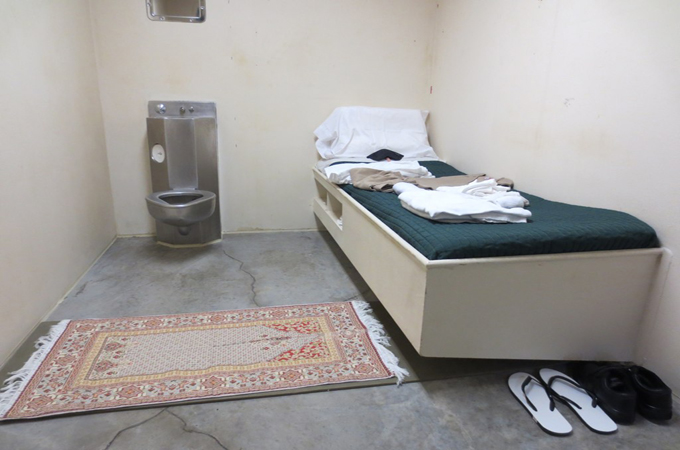 |
| A cell inside Camp 6 neatly displaying the items prisoners detained there receive [Jason Leopold/Al Jazeera] |
During a walk-through of an empty cellblock in Camp 5, we were led into the “media room,” about the size of a cell, where a dirty reclining chair faced a television set. At the foot of the recliner were leg shackles and next to the television set was a force-feeding kit, a grim reminder of the prolonged and widespread hunger strike that brought me here looking for answers.
All of the cells had surveillance cameras attached to the ceiling. Prison garb – white for compliant prisoners and orange for those who misbehave – was neatly laid out on a thin mattress pad along with toiletries provided to the inmates: toothbrush, toothpaste and soap.
Camp 5 is maximum security, holding the most troublesome prisoners in isolation 22 hours a day, with two hours out of their cells for showers and “recreation.”
Prisoners at Camp 6, on the other hand, were once allowed to leave their cells and mingle freely with other prisoners in a communal living arrangement where they shared meals, a recreation yard and gym privileges. There once was free access to satellite television, video games, DVDs, books and a wide range of comfort items.
That all changed two months into the hunger strike, when tensions flared and violence erupted, culminating in an April 13 pre-dawn raid by the guards. Since that time, occupants of Camp 6 have been confined to their cells in isolation, the same as residents of Camp 5. They are wakened as early as 3 a.m. for their two hours of recreation time.
Mutual contempt
The crackdown has done little to enhance relations between captors and captives, some of whom have spent more than a decade occupying this peculiar state of 8-by-10 limbo – untried, uncharged and with little hope of resolution.
Suicide attempts – some successful – have been documented among prisoners over the years. Now it seems the unprecedented hunger strike – a form of slow and deliberate mass suicide – is the only means of control at their disposal.
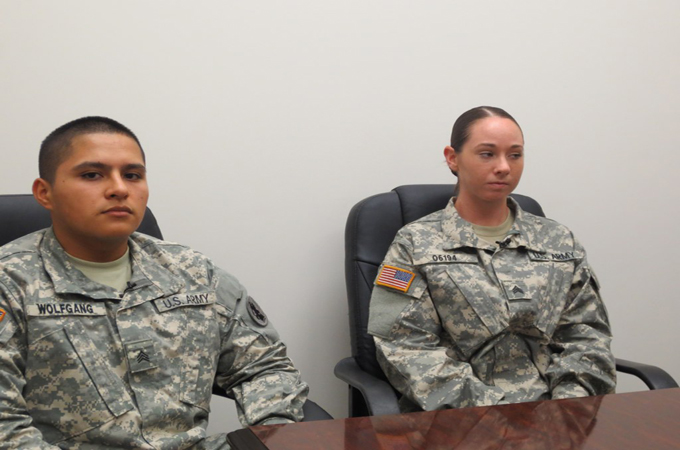 |
| Two Guantanamo guards Joint Task Force-Guantanamo made available for a 20-minute interview. They were the only two member of the military who permitted us to photograph their faces [Jason Leopold/Al Jazeera] |
If any of this is taking a toll on the guard force, it doesn’t seem to show.
Two young guards that public affairs officers made available to us for a 20-minute interview – a 20-year-old man with the nametag “Wolfgang” pinned to his chest, and a 21-year-old woman identified only as Number O6194, openly displayed their contempt for the captives.
“They will take anything you say and manipulate it. They lie consistently,” said Number 06194, the female Camp 5 guard who arrived at Gitmo last November. She said she worked as a prison guard at Fort Leavenworth prior to her deployment.
“Their biggest way to act out is to throw feces at guards, and it’s been happening consistently for the past month-and-a-half. Every day there is a splashing,” she said. “Your battle buddies help you clean up, and then you go right back to work.”
She said she has also been subjected to verbal abuse.
“The most common [vulgarities] are bitch, whore, slut and I’ll piss all over your face,” she said. “They’ll go on for hours and hours and hours. They know English very well.”
She said her background working in corrections prepared her for dealing “with these people.”
Such behavior is not unique to Guantanamo, according to Brandon Neely, a former Guantanamo guard who said the military highlights “splashing” incidents for public relations purposes.
While he does not condone it, he said it’s far worse at state prisons where he worked for more than two years.
“It’s one of the reasons I left [the state prison] and got another job,” Neely said. “I worked at the Ferguson Unit in Midway, Texas. I got pissed on and splashed. If you’re going to Gitmo from working in a prison background, you know this happens. I mean, it’s sad and I feel bad for the guards, but what do you expect when these guys are locked up for 11 years?”
As for cursing at guards, that happens at state prison all the time, Neely said.
“Detainees there will see a female guard and masturbate, call them bitches, whores, sluts. They make a big deal about this stuff happening at Gitmo. But trust me, it’s worse in state prison where you have convicted rapists and murderers. People at Gitmo haven’t even gone through the system.”
Military officials say the guard force at Guantanamo consists of experts in corrections, who have come from Leavenworth and Ft. Lewis for a one- or two-year rotation, as well as reservists or National Guardsmen who may have some law enforcement experience.
All go through a 12-day class, which includes cultural and resiliency training and scenarios to watch out for, such as splashing incidents. The course is designed to help the new guards deal “with the stresses of Gitmo”.
Detainees are actually living longer here compared with the lifespan of their home countries
Some guards I encountered on my own at Gitmo told me they were shown video clips of the 9/11 attacks before their deployment, and some had visited Ground Zero in New York City.
“Wolfgang,” the guard we were permitted to interview during the official tour, said he was a civilian before arriving at Guantanamo in June 2011. He did not have previous experience working in a prison environment.
When asked about the hunger strike, he, too, said the prisoners aren’t hunger striking, despite the fact that their attorneys have said in sworn statements their clients have shed up to 60 pounds and that according to the military, a full quarter of the inmate population – 41 prisoners – are being force fed as of this writing.
“When these detainees go out to rec they will share their food with their brothers,” “Wolfgang” said. “They’re eating. They’re definitely eating. The numbers [of hunger strikers] may go up, but everything is still the same.”
The female guard agreed.
“Are they really hunger striking? No,” she said.
This conflicts with details provided by the same guards about the procedure they follow in strapping prisoners who are near death into restraint chairs for force feedings.
“It’s done in a manner in which no marks are left on them,” the female guard said. “It’s a very comfortable setting. If they request pillows to sit on we give them pillows.
Both guards took issue with the way the hunger strike has been portrayed in the media and feel the prisoners who have been indefinitely detained without charge or trial for more than a decade have garnered way too much sympathy.
“It’s not being portrayed honestly,” the female guard said. The media comes here and “writes what they think they saw. But we know in our hearts and minds what goes on in there.”
At the detention hospital, where we were shown a restraint chair and force-feeding kit, the characterizations of the captives were not much different.
“These are a challenging set of patients we are dealing with,” said a senior medical officer, a physician, who also did not disclose his name. “They do not thank us for our good work. I’m not used to that.”
Meanwhile, the registered nurse who had selected the alter ego “Leonato,” seemed to embrace his Shakespearean theme that this was all “Much Ado About Nothing.”
“Detainees are actually living longer here compared with the lifespan of their home countries,” he said.
As for the reason some prisoners have developed diabetes, as documented in a recently released autopsy report, and are overweight, the physician said, “because they choose to overeat”.
At the end of the day, I met with some of the prisoners’ military defense lawyers, who told a completely different story about the way their clients are treated.
So much for universal truths.
Really surreal
Guantanamo is a strange and fascinating place. We traveled by ferry to the main part of the island and I had to constantly remind myself that despite the spectacular view of the coastline and bay, we were en route to see a prison operation where hundreds of men in the custody of the U.S. military were systematically tortured, according to a 2009 report issued by the Senate Armed Services Committee.
Although it is synonymous with the detention operations established by the Bush administration in January 2002, Guantanamo is actually a 45-square-mile naval base that the U.S. has occupied for a century. More than 6,000 military personnel, civilians and contractors live and work there.
The naval base, dotted with all-American fast-food chains, including a McDonald’s, Subway, Taco Bell and Pizza Hut, resembles a small town. There’s a high school, (where two dozen or so students were gearing up for their first tour of the prison), an outdoor movie theater, a local radio station, bars, beaches, and single-family homes and townhouses. Seeing children’s play sets in the backyards of several homes was surreal given Guantanamo’s symbolism.
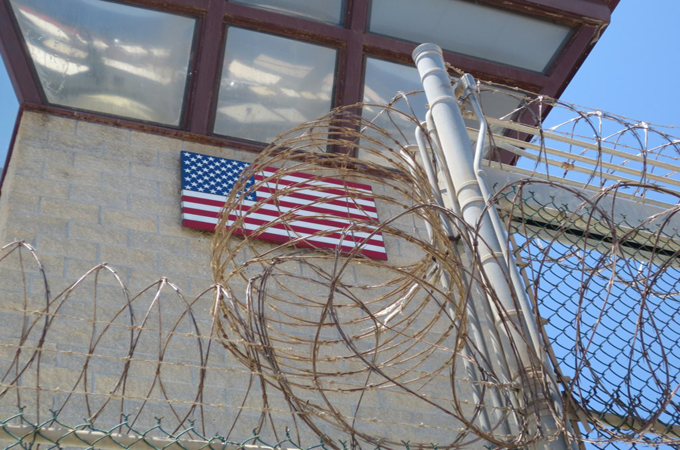 |
| The guard tower overlooking Camps 5 and 6, where prisoners who are engaged in a hunger strike are now living in solitary confinement [Jason Leopold/Al Jazeera] |
So was the view from Camp Iguana, which sits on a cliff overlooking the bay. From a distance, it resembles a celebrity compound in Malibu, California. Right below Camp Iguana, which houses prisoners who reside in an interminable state of pre-release, military personnel were sunbathing on the beach.
For some of the men and women who work at Guantanamo, it’s as if the prison does not even exist. A Jamaican man who has been living there for 16 years and works the door at O’Kelly’s – “the only Irish pub on communist soil,” its slogan boasts – said, “I don’t pay any attention to that drama”.
“America’s gotta do what America’s gotta do,” he said, refusing to disclose his name.
We have to pass through a security gate manned by armed guards, one of whom holds an assault rifle. It is the only place at the prison where lethal weapons are permitted. As we approach Camp Delta, which at one time housed all of the detention camps, we are greeted by 10 concrete pillars that spell out “Honor Bound”.
And then there was Camp X-Ray.
X-Ray: The beginning
The day before our departure from Guantanamo we’re given a tour of Camp X-Ray, the last stop on the media tour. Camp X-Ray was where prisoners were first held when the prison opened in January 2002. It is located on the naval side of the island.
Camp X-Ray looks just like a concentration camp. That’s my immediate reaction as we’re led inside the gate and see the tiny open-air cages lined up next to each other on cement floors where prisoners slept beside buckets that served as toilets, the crude outdoor showers, and what seemed like miles of razor wire.
On this hot day, with the sun beating down and the mosquitoes nipping at our necks, it is easy to imagine what the prisoners endured.
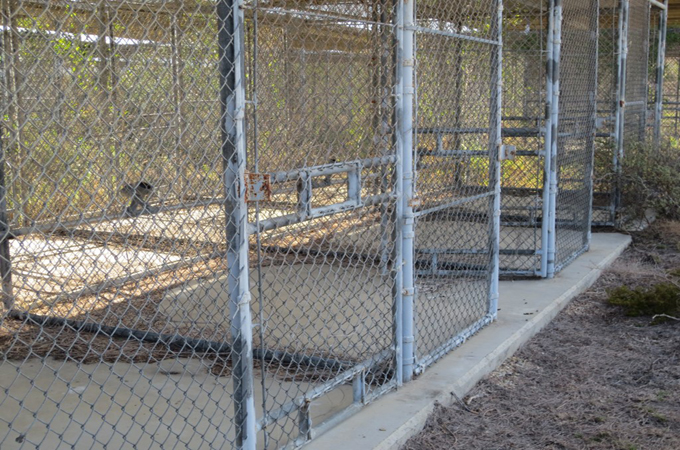 |
| These are the “cells” at Camp X-Ray that were used to house the first prisoners transferred to Guantanamo in January 2002. They were placed in open air cages where they remained for three months before being sent to the camps that were being built by former Halliburton subsidiary Kellogg, Brown & Root [Jason Leopold/Al Jazeera] |
Sgt. Brian Godette, our escort, points to a dilapidated structure in the distance that he said used to house military dogs, the ones that were used to intimidate the prisoners. The dogs had better accommodations than the prisoners.
He shows us three interrogation huts where prisoners were tortured.
In the distance stands an isolation cage where one prisoner was held for the duration of his detainment at X-Ray. Former Guantanamo guard Brandon Neely, who worked at Camp X-Ray when it opened and escorted the first prisoners off the bus, said Martin John Mubanga, who held dual citizenship in the United Kingdom and Zambia, was held in the isolation cage.
One of the military escorts, who has visited X-Ray numerous times, says she still can’t believe “this is what our country did”.
X-Ray held hundreds of prisoners for about three months. It is now smothered in weeds and grass. A federal judge ordered the structures to be preserved as possible evidence.
A banana rat, the size of a cat, crawls along a thick strand of barbed wire and disappears inside a cell that is engulfed in overgrowth.
It is an image that will stay with me long after some of the others have faded. Why, I don’t know. It was, after all, just another day at Guantanamo Bay. And yet in this abandoned place, where it all began, I may have found a morsel of the truth I was seeking.
Follow Jason Leopold on Twitter: @JasonLeopold